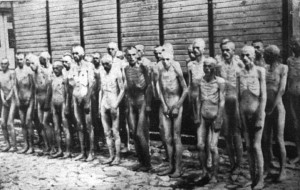Christian Gerlach and Nicolas Werth’s essay, “”State Violence-Violet Societies” discusses the use of mass violence in camp systems. Gerlach and Werth analyzed the methods of violence, the intensity of the violence, the role of the State in the violence, and the ideology behind the violence.1 Gerlach and Werth argued that in Germany the eradication policies were multicausal and that the archival revolution in Russia allowed historians to grasp the foundation of Soviet violence.2
The part of this article that caught my attention was the section on prisoners of war. In this section, the authors discussed “unfit” Soviet workers left to die from starvation.3 Upon hearing the phrase mass violence, my thoughts involve images of large scale killings such as gas chambers and weapons. However, this was hardly the case for Soviet POWs. Although many Soviet citizens lost their lives each day, a minority were killed together all at once. Malnutrition was the leading cause of death.4 However, regardless of whether killed by weapons or lack of food, the Soviet officials did the doing.
This section on Soviet POWs changed my prospective of mass violence. Gerlach and Werth shed light on the key aspect of isolation in Soviet Union concentration camps in harsh conditions, leading to malnutrition. Nazi concentration camps are so commonly portrayed in media that this had shaped my perception of violence within dictatorships. As I read about Soviet concentration camps, I learned a new perspective to mold into my view of mass violence. Did this essay change your view of mass violence? Besides “unfit workers”, what were some other groups the Soviet Union targeted as POWs? How does the Soviet Union differ from Nazi Germany with their management of POWs?
1. Christian Gerlach and Nicolas Werth, “State Violence- Violent Societies” in Beyond Totalitarianism: Stalinism and Nazism Compared, ed. Michael Geyer and Sheila Fitzpatrick (New York: Cambridge University Press, 2009), 133.
2. Gerlach and Werth, “State Violence- Violent Societies” in Beyond Totalitarianism, 135.
3. Gerlach and Werth, “State Violence- Violent Societies” in Beyond Totalitarianism, 162.
4. Gerlach and Werth, “State Violence- Violent Societies” in Beyond Totalitarianism, 163.


This reading was fairly fascinating to me. I did not see it as something that permanently changed my thoughts on the Concentration camps in Nazi Germany or the Gulag in the Soviet Union in particular. Instead, it was a nice contribution to the study on prison camps during the 1930s and 1940s. In Gerlach and Werths essay, they make the point that the only plan for the Soviet State was to “control and eradicate all forms of national particularism that did not accord with the global project of the Soviet Empire of nations.” ((Gerlach and Werth, “State Violence- Violent Societies” In Beyond Totalitarianism, 160)). They believed that the only goal of the state was to send off all people who seemed to be a threat to the state. However, historian Steven Barnes 2011 book complicates this argument. Steven Barnes argues in his 2011 book, Death and Redemption, that people were not simply sent to the Gulags simply because they were enemies of the state; instead, they were sent to the camps because they were also seen to be uneducated Soviet Citizens. Barnes pointed out that If Soviet Citizens were deemed reeducated, they would be allowed back into society. ((Barnes, A. Stephen. Death and Redemption: The Gulag and the reshaping of Soviet Society: Princeton: Princeton University Press, 2011.)) At the same time, people who went to these camps would often die because of rather harsh living conditions.
I think that Gerlach and Werths points on POWs are certainly interesting. I would be fascinated to see if and how Steven Barnes talks about POWs in the Gulags. That would be an interesting contribution! The POW part also reminded me of the 2001 film, “As Far As My Feet Will Take Me” in that it showed the harsh conditions of a siberian Gulag and the life for German POWS. I am not sure how much of it is historically accurate in a sense, but the film was an interesting flashback when I read about the POWS in the Soviet Union.
I found that this article by Gerlach and Werth added to my understanding, rather than changed my view on the use of mass violence in Nazi Germany and the Soviet Union. The most intriguing section in my opinion, was the section about the deportation of Korean minorities and six ethnic groups as well as the other episodes of ethnic cleansing in the Soviet Union. While reading this I thought it reflected policies associated with Nazi Germany as opposed to policies of the Soviet Union. The authors evaluate this debate over whether “traces of racial policies crept into Soviet nationalities policies” ((Gerlach and Werth, “State Violence-Violent Societies” in Beyond Totalitarianism, 158-160)). While at first I thought yes it had, reading further this type ethnic cleansing does relate to the ideology of the Soviet Union. It was not a desire to rid the country of certain racial traits, but an attempt to eliminate cultural and historical identities that hindered the progression towards the Soviet ideas of a utopian society ((Gerlach and Werth, “State Violence-Violent Societies” in Beyond Totalitarianism, 160)).
In regards to your question about the differences between the treatments of POWs in Germany versus the treatment of POWs in the Soviet Union, the treatment of POWs in Nazi captivity was methodically calculated compared to those in Soviet captivity. Unlike the POWs in the Soviet Union, there was a conscious effort made by Germany officials to separate, kill and undersupply certain sections of POWs ((Gerlach and Werth, “State Violence-Violent Societies” in Beyond Totalitarianism, 160-161)). This contrasts with the Soviet’s treatment of POWs. German POWs in the Soviet Union worked alongside soviet prisoners, and to some extent Soviet officials sought to better the prisoners’ living conditions (although this should not be over emphasized). There was no premeditated plan that dictated the treatment of Germany POWs. ((Gerlach and Werth, “State Violence-Violent Societies” in Beyond Totalitarianism, 171)).